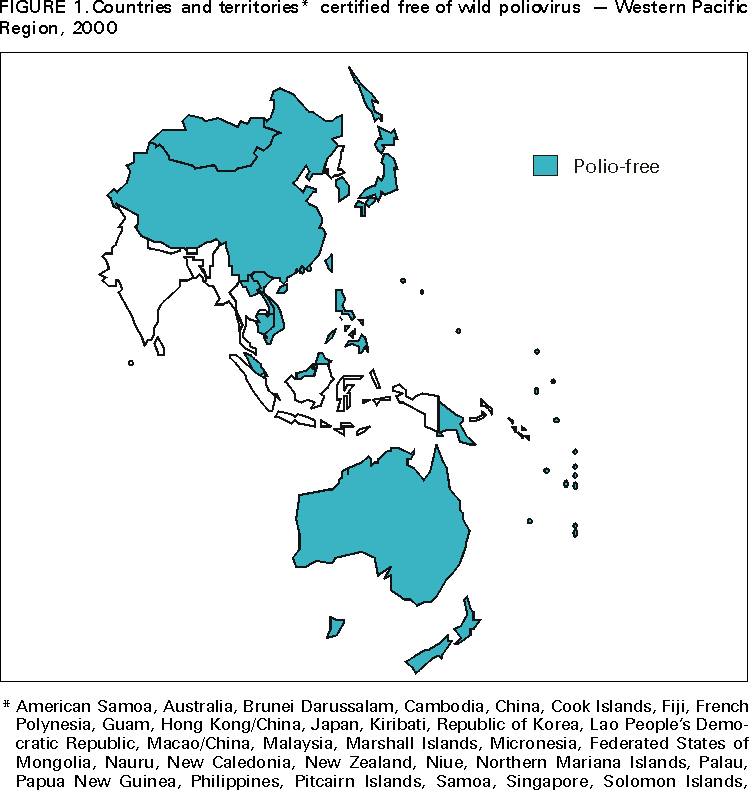 |
|
|
|
|
|
|
| ||||||||||
|
|
|
|
|
|
|
||||
| ||||||||||
|
|
|
|
|
Persons using assistive technology might not be able to fully access information in this file. For assistance, please send e-mail to: mmwrq@cdc.gov. Type 508 Accommodation and the title of the report in the subject line of e-mail. Public Health Dispatch: Certification of Poliomyelitis Eradication --- Western Pacific Region, October 2000On October 29, 2000, the Regional Commission for the Certification of Poliomyelitis Eradication certified that the Western Pacific Region (WPR) of the World Health Organization (WHO) is free of indigenous wild poliovirus transmission. The last known case of indigenous poliovirus transmission occurred in Cambodia in March 1997 in a 15-month-old girl. WPR is the second of the six WHO regions to be certified as poliomyelitis-free; the first was the Region of the Americas in 1994 (1). WPR comprises 37 countries and territories* (Figure 1) with an estimated 1.6 billion persons (27% of the world's population) (2). The commission completed a 5-year review of programmatic data compiled by national certification committees to ensure that the absence of reported wild poliovirus isolation reflected interruption of indigenous transmission. The prerequisite for regional certification is the absence of indigenous wild poliovirus isolation for at least 3 years (3). Other criteria used to certify that countries and regions are polio-free include 1) high vaccination coverage rates in all countries and within all areas of a country; 2) sensitive surveillance for detecting all cases of acute flaccid paralysis (AFP) meeting standard performance indicators (e.g., the processing of all stool samples from AFP case-patients in WHO-accredited laboratories); 3) a plan of action to respond to imported cases of polio and poliovirus; and 4) political commitment by national governments to maintain polio eradication activities at current levels of intensity until at least 2005. WPR is the first region to include the biocontainment of wild polioviruses in laboratories as part of the certification process. In its initial phase, this process entails conducting inventories of all stocks of wild poliovirus infectious materials and potentially infectious materials. Completion of this phase in WPR is expected in December 2001. In 1988, the Global Poliomyelitis Eradication Initiative was established by the World Health Assembly and was coordinated by WHO, the United Nations Children's Fund (UNICEF), Rotary International, and CDC; it is the largest public health effort for disease eradication. National governments, private foundations, nongovernmental organizations, corporations, and volunteers have collaborated to achieve eradication. In the European Region, no new indigenous polio cases have been detected since November 1998. Twenty countries in the three other WHO regions (Africa, Eastern Mediterranean, and South-East Asia) anticipate continued poliovirus transmission; global circulation of poliovirus may be interrupted by 2002 (4). The occurrence of an imported case of polio in China in October 1999 (5) and the documented transmission of wild poliovirus in areas bordering WPR during 2000 (4) underscore that the continued circulation of poliovirus in the three WHO regions pose a risk for reintroduction to all polio-free countries. Polio-free countries should maintain high levels of polio vaccination coverage and sensitive surveillance for the prompt detection of any circulating poliovirus. To minimize the risk for poliovirus importation, supplementary vaccination campaigns will be required in high-risk areas, especially those bordering countries where polio is endemic. During 2000, an outbreak of vaccine-associated polio was documented among populations with low poliovirus vaccine coverage in the Dominican Republic and Haiti (6). Global certification of polio eradication will be required before consideration of discontinuing polio vaccination. Reported by: Western Pacific Regional Office, World Health Organization, Manila, Philippines. Vaccines and Other Biologicals Dept, World Health Organization, Geneva, Switzerland. Respiratory and Enteric Viruses Br, Div of Viral and Rickettsial Diseases, National Center for Infectious Diseases; Vaccine Preventable Disease Eradication Div, National Immunization Program, CDC. References
* American Samoa, Australia, Brunei Darussalam, Cambodia, China, Cook Islands, Fiji, French Polynesia, Guam, Hong Kong/China, Japan, Kiribati, Republic of Korea, Lao People's Democratic Republic, Macao/China, Malaysia, Marshall Islands, Micronesia, Federated States of Mongolia, Nauru, New Caledonia, New Zealand, Niue, Northern Mariana Islands, Palau, Papua New Guinea, Philippines, Pitcairn Islands, Samoa, Singapore, Solomon Islands, Tokelau, Tonga, Tuvalu, Vanuatu, Viet Nam, Wallis and Futuna Islands. Figure 1  Return to top. Disclaimer All MMWR HTML versions of articles are electronic conversions from ASCII text into HTML. This conversion may have resulted in character translation or format errors in the HTML version. Users should not rely on this HTML document, but are referred to the electronic PDF version and/or the original MMWR paper copy for the official text, figures, and tables. An original paper copy of this issue can be obtained from the Superintendent of Documents, U.S. Government Printing Office (GPO), Washington, DC 20402-9371; telephone: (202) 512-1800. Contact GPO for current prices. **Questions or messages regarding errors in formatting should be addressed to mmwrq@cdc.gov.Page converted: 1/10/2001 |
|||||||||
This page last reviewed 5/2/01
|